
Tuesday, October 14, 2008
A Mystery
Dr. Joseph Kunkel from the University of Massachusetts at Amherst is investigating a mystery on board our ship. In the last few years, fisherman and biologists have all noticed that lobsters are disappearing from waters south of cape cod near shore. This includes Narragansett Bay and our own Long Island Sound. Why? Thats' what Dr. Kunkel is trying to find out.
He and other scientists have found that the lobsters are infected with a bacteria. Dr. Kunkel has a hypothesis. He believes that some lobsters get the bacteria because their shells are not as strong as other lobsters and don't protect them as well. He is here collecting samples to test his hypothesis.
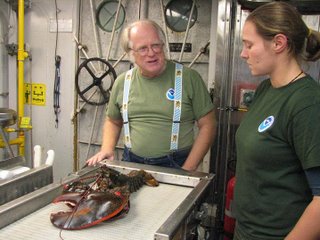 Here is Doctor Kunkel collecting samples with Watch Chief Mel Underwood.
Here is Doctor Kunkel collecting samples with Watch Chief Mel Underwood.
He has even made a discovery. He and another scientist, named Dr. Jercinovic, discovered that this shell fish actually has boney material in certain places in the shell. The boney material helps make the lobster strong enough to resist the bacteria. Effected lobsters may not have as much bone, so their shells are weaker. Why are the shells weaker? There may be a few reasons.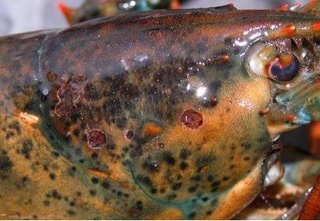
The water South of Cape Cod is warmer than it normally is. Climate change may be to blame.
The water has a lot of pollution from cities like New York and Boston.
There are many streams and rivers pouring into the area that are Affected by acid rain.
All of these things may effect the lobsters in the sea. They may effect other creatures in the sea as well. Can you think of things that are happening in our neighborhood that may contribute to this problem? Post your ideas on the blog and I will share them with Dr. Kunkel. What does shell disease look like? Can you see the red spots on the photo on the right? That is shell disease. It can get much worse. Thanks Dr. Kunkel for sharing your work and your photograph.
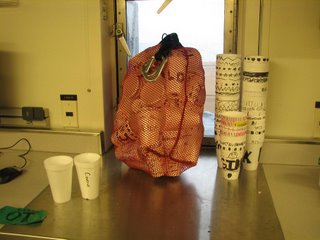
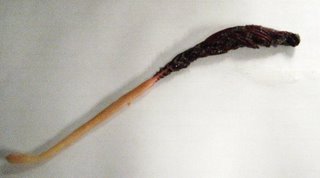
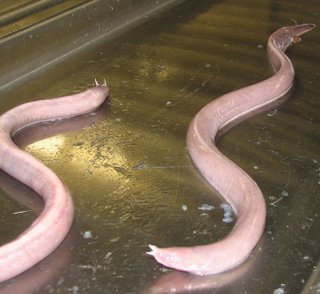 This is a sea-hag. It is a snake-like fish that has some amazing teeth. We put one inside a plastic bag for a few minutes to watch it try to eat its way out. Take a look at this video to see what happened.
This is a sea-hag. It is a snake-like fish that has some amazing teeth. We put one inside a plastic bag for a few minutes to watch it try to eat its way out. Take a look at this video to see what happened.
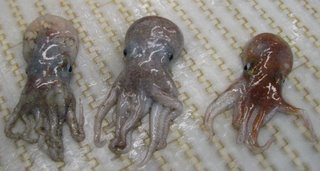 Here are three Spoon Arm Octopi. Each octopi has three hearts, not one. One pumps blood through the body and the other two pump blood through the gills. There are three octopi in this photo. How many hearts to they have in all?
Here are three Spoon Arm Octopi. Each octopi has three hearts, not one. One pumps blood through the body and the other two pump blood through the gills. There are three octopi in this photo. How many hearts to they have in all?
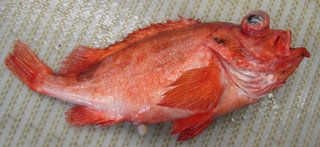 This redfish are also an interesting criters. When they lay eggs, you can see the babies inside. They live in deep water. We caught this one at a depth of 300 meters. How many feet is that?
This redfish are also an interesting criters. When they lay eggs, you can see the babies inside. They live in deep water. We caught this one at a depth of 300 meters. How many feet is that?
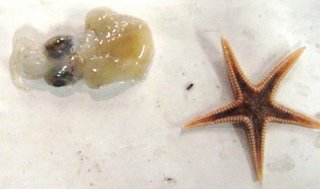
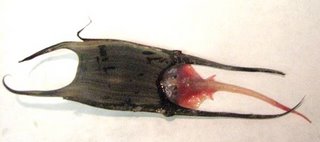
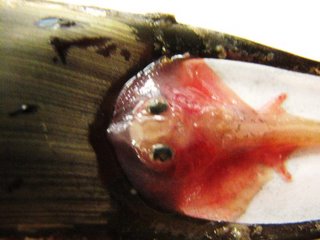 This skate case had a baby skate inside. Here is what it looked like as the tiny creature emerged.
This skate case had a baby skate inside. Here is what it looked like as the tiny creature emerged.
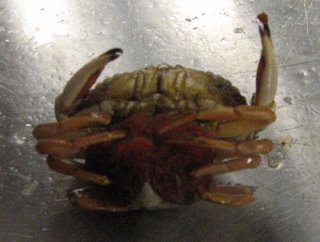 Finally, the red on the underside of this crab are the eggs. Biologists call them roe.
Finally, the red on the underside of this crab are the eggs. Biologists call them roe.
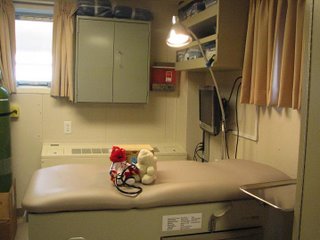
He and other scientists have found that the lobsters are infected with a bacteria. Dr. Kunkel has a hypothesis. He believes that some lobsters get the bacteria because their shells are not as strong as other lobsters and don't protect them as well. He is here collecting samples to test his hypothesis.
He has even made a discovery. He and another scientist, named Dr. Jercinovic, discovered that this shell fish actually has boney material in certain places in the shell. The boney material helps make the lobster strong enough to resist the bacteria. Effected lobsters may not have as much bone, so their shells are weaker. Why are the shells weaker? There may be a few reasons.

The water South of Cape Cod is warmer than it normally is. Climate change may be to blame.
The water has a lot of pollution from cities like New York and Boston.
There are many streams and rivers pouring into the area that are Affected by acid rain.
All of these things may effect the lobsters in the sea. They may effect other creatures in the sea as well. Can you think of things that are happening in our neighborhood that may contribute to this problem? Post your ideas on the blog and I will share them with Dr. Kunkel. What does shell disease look like? Can you see the red spots on the photo on the right? That is shell disease. It can get much worse. Thanks Dr. Kunkel for sharing your work and your photograph.
The art teachers, Mrs. Bensen in CLE and Mrs. Piteo in WOS had groups of students decorate Styrofoam cups for an experiment on the ship involving technology, water pressure in science and perspective in art. You probably have felt water pressure. When you swim to the bottom of the deep end of a pool, you may have felt your ears pop. This is water pressure. It is caused by the weight of the water on top of you pushing down on you. Well, a pool is only 10 or 12 feet deep. Just imagine the pressure at 600 feet down. We wanted to do an experiment with water pressure. Since Styrofoam is has a lot of air in it, we wanted to see what happened when we sent the decorated cups to the bottom of the sea. Click here for a video and see for yourself. If you decorated a cup, you will get it back when I come in next week.
Here are some more interesting creatures that came up in our nets overnight. We have been in deeper water and some some of the creatures have been quite interesting.
This “sea pen” is a type of soft coral.
Here is a bobtail squid and a sea-start. The squid looks like an octopus, but it is not.
Zee and Snuggy paid a visit to the ship's hospital to take a look around. Here is a photo. The hospital is amazing. They are able to treat a wide variety of injuries and ailments without having to call for help. They can even put in stiches if they need to. In cases of serious injury, however, the Coast Guard would have to take the patient to land with the helicopter or fast boat. Zee and Snuggy had a great time touring the hospital, and all three of us are just fine.
----------------------
Answers to Questions and Comments:
NN – People and birds are the only creatures I have seen so far that can live on land. I've seen lots of each. Thanks for checking in.
NN – People and birds are the only creatures I have seen so far that can live on land. I've seen lots of each. Thanks for checking in.







